Abstract
BACKGROUND: Salmeterol and formoterol have a lower intrinsic activity at beta 2 receptors than isoprenaline in human bronchus in vitro. The aim of the present study was to evaluate in vivo the beta 2 agonist/antagonist activity of salmeterol and formoterol at rest with low endogenous adrenergic tone, on exercise with raised endogenous adrenergic tone, and in the presence of fenoterol, an exogenous full beta 2 receptor agonist. METHODS: Eight normal subjects were randomised to receive single doses of placebo, salmeterol 300 micrograms, formoterol 72 micrograms, or propranolol 80 mg at weekly intervals. beta 2 adrenoceptor responses were evaluated at rest, at peak exercise, and after treatment with fenoterol 2.4 mg. RESULTS: At rest salmeterol and formoterol exhibited equivalent beta 2 agonist activity with regard to decrease in serum potassium levels and increase in finger tremor, with propranolol having no effect. Salmeterol and formoterol, like propranolol, potentiated the hyperkalaemic delta response to exercise compared with placebo, consistent with beta 2 antagonism: (mean difference and 95% confidence interval (CI) compared with placebo) salmeterol 0.20 (0.02 to 0.38) mmol/l, formoterol 0.17 (0.00 to 0.34) mmol/l, propranolol 0.45 (0.08 to 0.82) mmol/l. Propranolol blunted the heart rate delta response to exercise, consistent with beta 1 blockade, whilst salmeterol and formoterol had no effect. Salmeterol and formoterol, like propranolol, attenuated the hypokalaemic, tremor, and heart rate delta responses to fenoterol compared with placebo, in keeping with beta 2 blockade: potassium, salmeterol 0.18 (0.0 to 0.36) mmol/l, formoterol 0.17 (-0.03 to 0.37) mmol/l, propranolol 0.80 (0.54 to 1.06) mmol/l; tremor, salmeterol -0.69 (-1.26 to -0.12) log units, formoterol -0.71 (-1.53 to 0.11) log units, propranolol -0.85 (-1.66 to -0.04) log units; heart rate, salmeterol -6 (-13 to 1) beats/min, formoterol -10 (-19 to -1) beats/min, propranolol -18 (-29 to -7) beats/min. CONCLUSIONS: At rest with low endogenous adrenergic tone salmeterol and formoterol showed equivalent beta 2 mediated agonist activity in terms of serum potassium and finger tremor responses. In the presence of raised endogenous adrenergic tone at peak exercise and in the presence of fenoterol (an exogenous full beta 2 receptor agonist), salmeterol and formoterol, like propranolol, exhibited beta 2 receptor antagonism as evidenced by their attenuation of beta 2 receptor mediated responses. The degree of beta 2 blockade with formoterol and salmeterol was comparable but less than with propranolol. The relevance of these findings at extrapulmonary beta 2 receptors with regard to airway beta 2 responses remains unclear and warrants further investigation.
Full text
PDF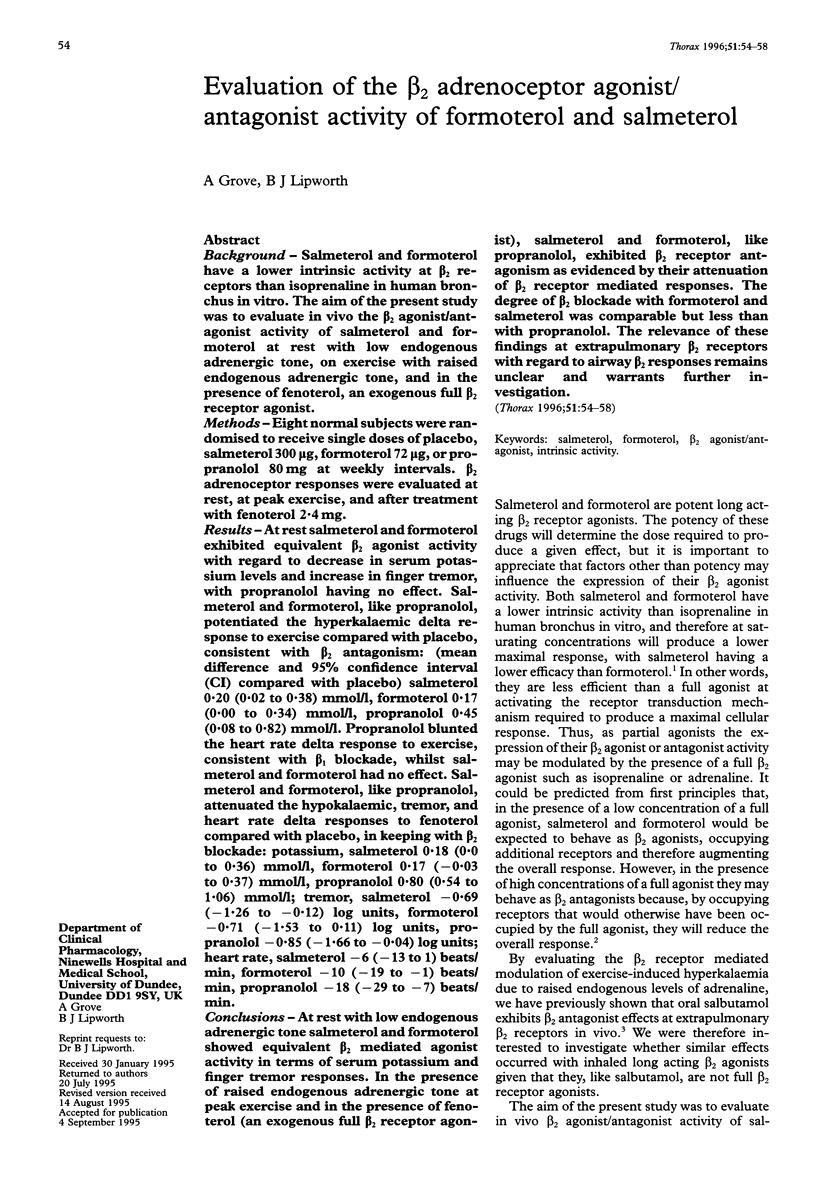
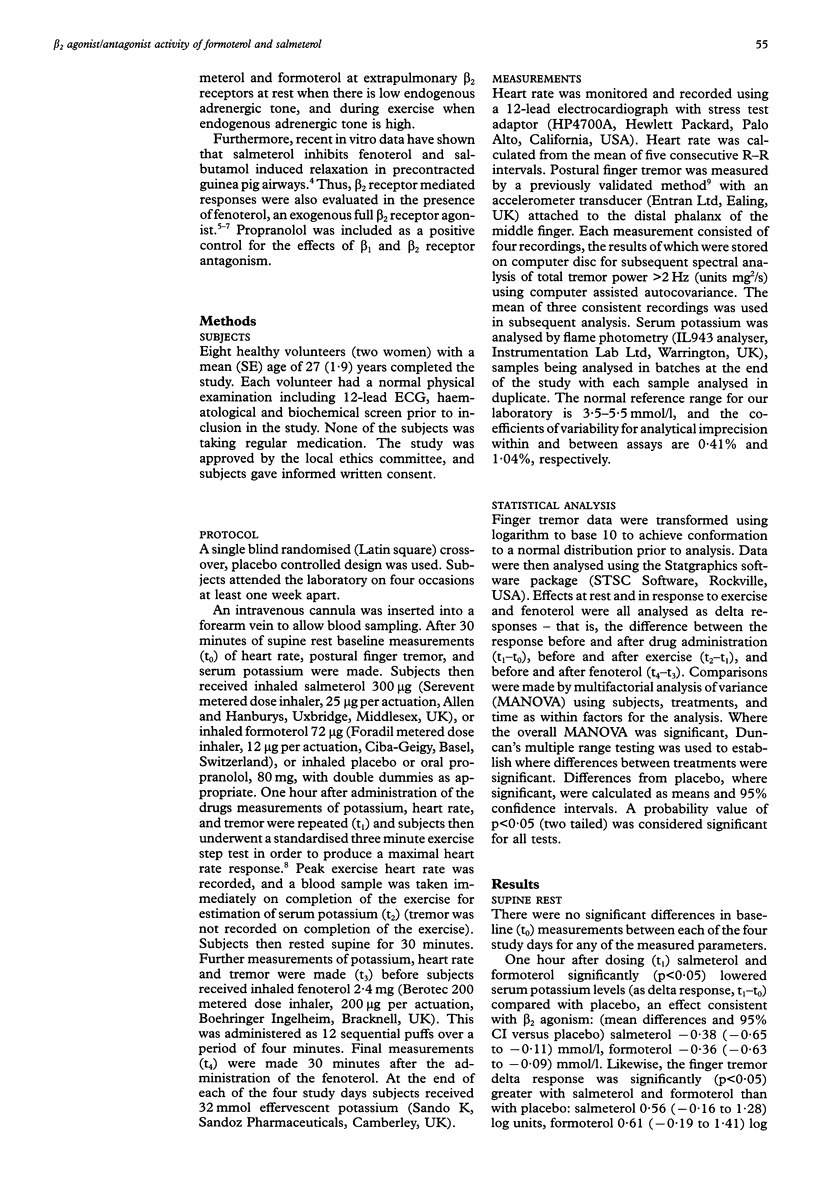
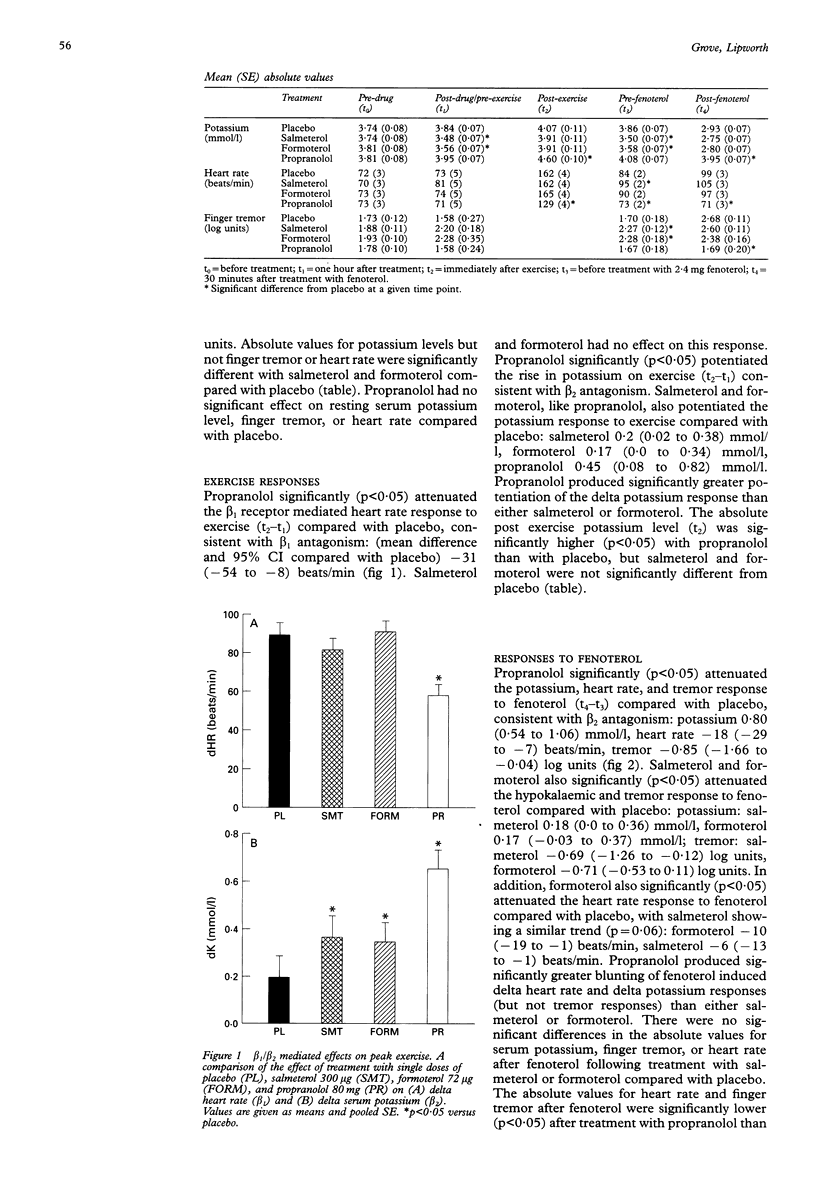
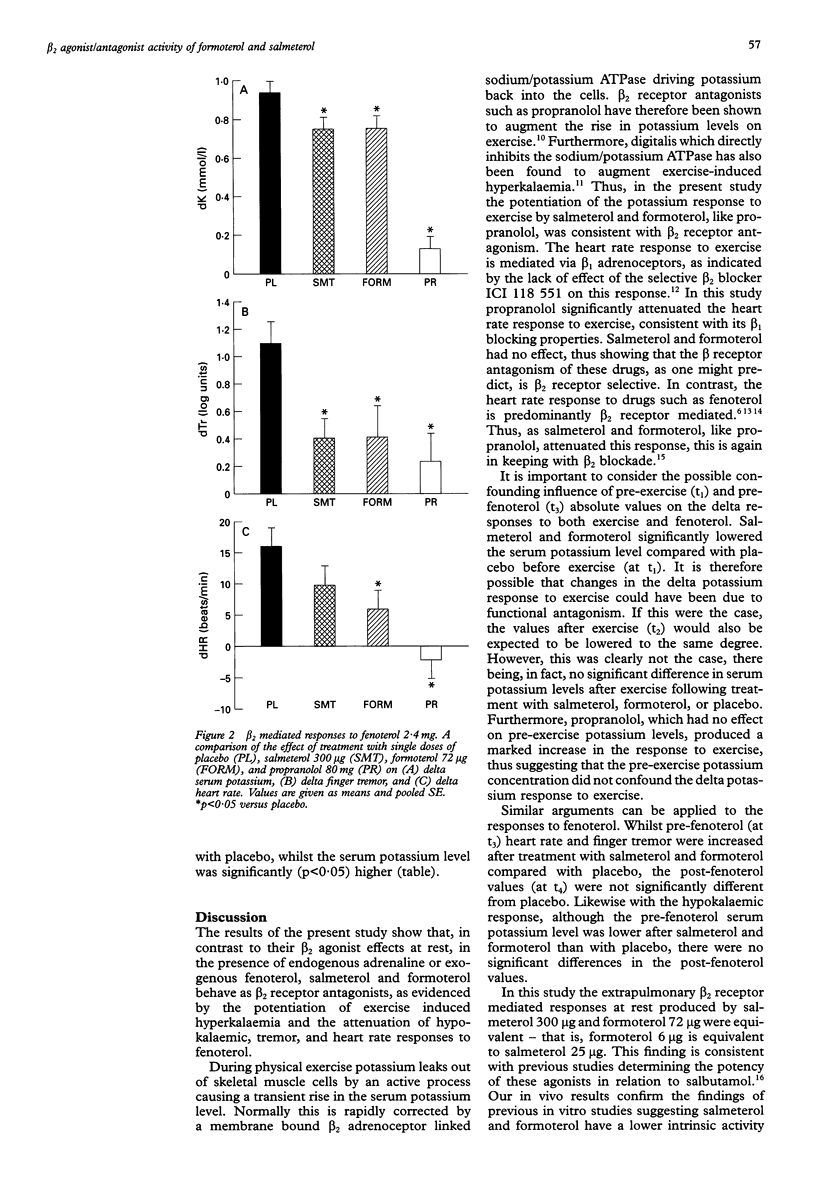
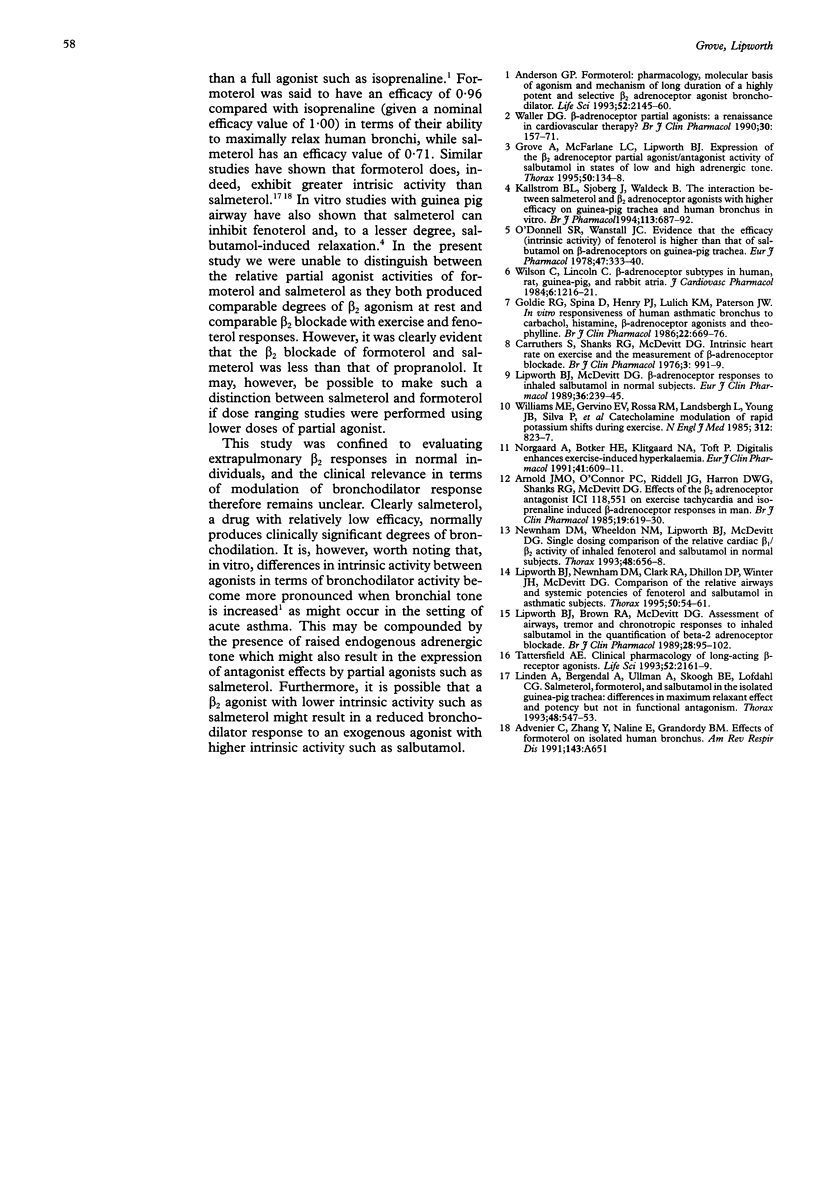
Selected References
These references are in PubMed. This may not be the complete list of references from this article.
- Anderson G. P. Formoterol: pharmacology, molecular basis of agonism, and mechanism of long duration of a highly potent and selective beta 2-adrenoceptor agonist bronchodilator. Life Sci. 1993;52(26):2145–2160. doi: 10.1016/0024-3205(93)90729-m. [DOI] [PubMed] [Google Scholar]
- Arnold J. M., O'Connor P. C., Riddell J. G., Harron D. W., Shanks R. G., McDevitt D. G. Effects of the beta 2-adrenoceptor antagonist ICI 118,551 on exercise tachycardia and isoprenaline-induced beta-adrenoceptor responses in man. Br J Clin Pharmacol. 1985 May;19(5):619–630. doi: 10.1111/j.1365-2125.1985.tb02689.x. [DOI] [PMC free article] [PubMed] [Google Scholar]
- Goldie R. G., Spina D., Henry P. J., Lulich K. M., Paterson J. W. In vitro responsiveness of human asthmatic bronchus to carbachol, histamine, beta-adrenoceptor agonists and theophylline. Br J Clin Pharmacol. 1986 Dec;22(6):669–676. doi: 10.1111/j.1365-2125.1986.tb02956.x. [DOI] [PMC free article] [PubMed] [Google Scholar]
- Grove A., McFarlane L. C., Lipworth B. J. Expression of the beta 2 adrenoceptor partial agonist/antagonist activity of salbutamol in states of low and high adrenergic tone. Thorax. 1995 Feb;50(2):134–138. doi: 10.1136/thx.50.2.134. [DOI] [PMC free article] [PubMed] [Google Scholar]
- Lindén A., Bergendal A., Ullman A., Skoogh B. E., Löfdahl C. G. Salmeterol, formoterol, and salbutamol in the isolated guinea pig trachea: differences in maximum relaxant effect and potency but not in functional antagonism. Thorax. 1993 May;48(5):547–553. doi: 10.1136/thx.48.5.547. [DOI] [PMC free article] [PubMed] [Google Scholar]
- Lipworth B. J., Brown R. A., McDevitt D. G. Assessment of airways, tremor and chronotropic responses to inhaled salbutamol in the quantification of beta 2-adrenoceptor blockade. Br J Clin Pharmacol. 1989 Jul;28(1):95–102. doi: 10.1111/j.1365-2125.1989.tb03510.x. [DOI] [PMC free article] [PubMed] [Google Scholar]
- Lipworth B. J., McDevitt D. G. Beta-adrenoceptor responses to inhaled salbutamol in normal subjects. Eur J Clin Pharmacol. 1989;36(3):239–245. doi: 10.1007/BF00558154. [DOI] [PubMed] [Google Scholar]
- Lipworth B. J., Newnham D. M., Clark R. A., Dhillon D. P., Winter J. H., McDevitt D. G. Comparison of the relative airways and systemic potencies of inhaled fenoterol and salbutamol in asthmatic patients. Thorax. 1995 Jan;50(1):54–61. doi: 10.1136/thx.50.1.54. [DOI] [PMC free article] [PubMed] [Google Scholar]
- Newnham D. M., Wheeldon N. M., Lipworth B. J., McDevitt D. G. Single dosing comparison of the relative cardiac beta 1/beta 2 activity of inhaled fenoterol and salbutamol in normal subjects. Thorax. 1993 Jun;48(6):656–658. doi: 10.1136/thx.48.6.656. [DOI] [PMC free article] [PubMed] [Google Scholar]
- Nørgaard A., Bøtker H. E., Klitgaard N. A., Toft P. Digitalis enhances exercise-induced hyperkalaemia. Eur J Clin Pharmacol. 1991;41(6):609–611. doi: 10.1007/BF00314994. [DOI] [PubMed] [Google Scholar]
- O'Donnell S. R., Wanstall J. C. Evidence that the efficacy (intrinsic activity) of fenoterol is higher than that of salbutamol on beta-adrenoceptors in guinea-pig trachea. Eur J Pharmacol. 1978 Feb 1;47(3):333–340. doi: 10.1016/0014-2999(78)90241-8. [DOI] [PubMed] [Google Scholar]
- Tattersfield A. E. Clinical pharmacology of long-acting beta-receptor agonists. Life Sci. 1993;52(26):2161–2169. doi: 10.1016/0024-3205(93)90730-q. [DOI] [PubMed] [Google Scholar]
- Waller D. G. Beta-adrenoceptor partial agonists: a renaissance in cardiovascular therapy? Br J Clin Pharmacol. 1990 Aug;30(2):157–171. doi: 10.1111/j.1365-2125.1990.tb03760.x. [DOI] [PMC free article] [PubMed] [Google Scholar]
- Williams M. E., Gervino E. V., Rosa R. M., Landsberg L., Young J. B., Silva P., Epstein F. H. Catecholamine modulation of rapid potassium shifts during exercise. N Engl J Med. 1985 Mar 28;312(13):823–827. doi: 10.1056/NEJM198503283121304. [DOI] [PubMed] [Google Scholar]
- Wilson C., Lincoln C. Beta-adrenoceptor subtypes in human, rat, guinea pig, and rabbit atria. J Cardiovasc Pharmacol. 1984 Nov-Dec;6(6):1216–1221. [PubMed] [Google Scholar]


